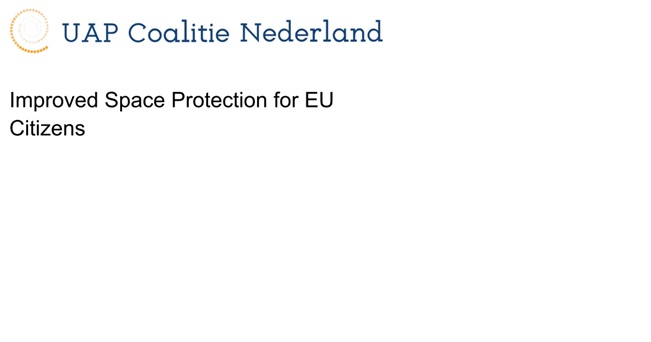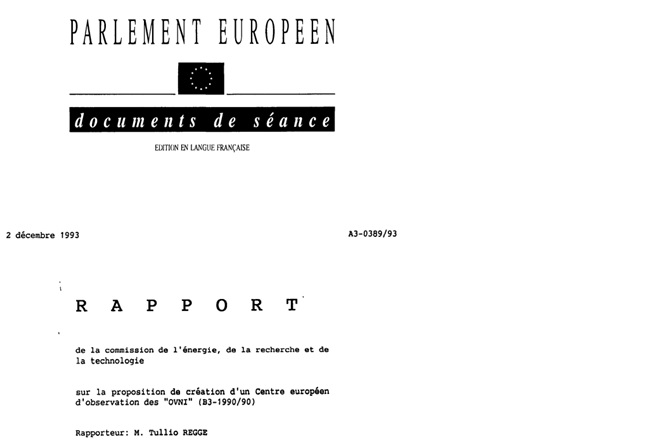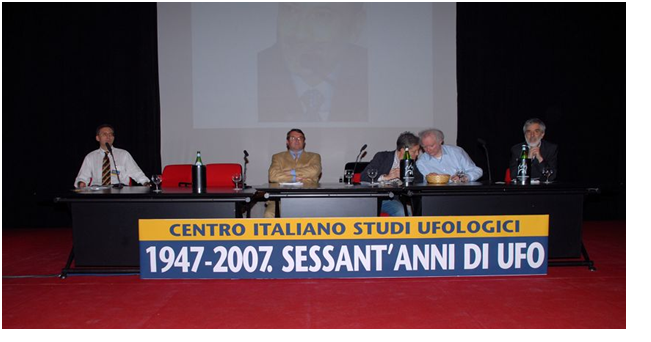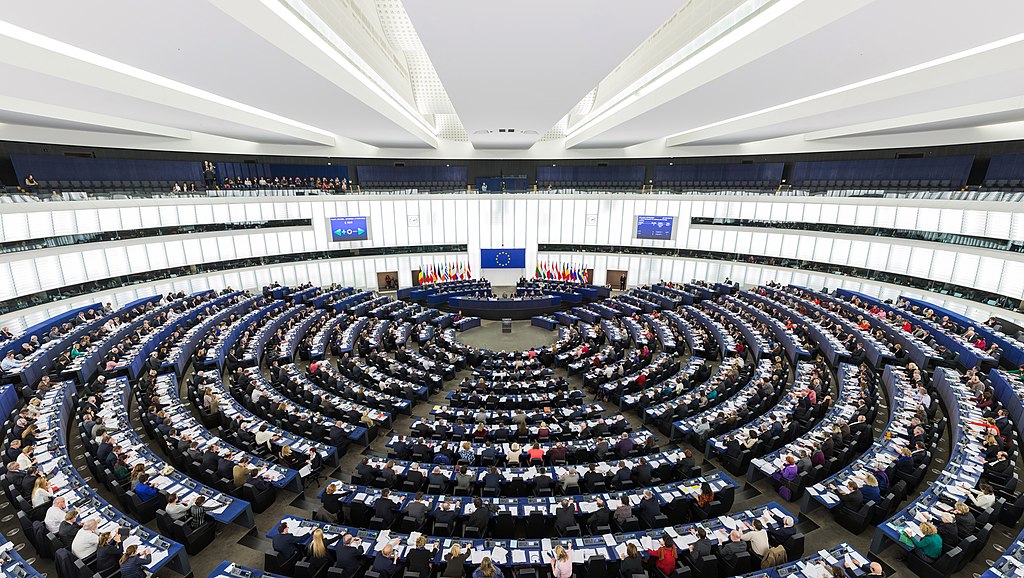The question of whether the UAP topic has been dealt with or whether (official) knowledge and documents are available does not stop at international institutions. The best known of these is probably the initiative of the Caribbean state of Grenada in the UN from 1975 to 1977 to set up a department at the UN to research UFOs, which ultimately did not lead to any further action. But there have also been requests and initiatives to the European Parliament on the subject of UFOs/UAP. On the occasion of this year's upcoming European elections, European UFO researchers are considering asking the parties and candidates standing for election how they would deal with the UAP issue. However, it is probably uncertain what can be expected from this, as this topic is likely to be of secondary importance in view of other current problems and challenges in Europe.
At this point, I would like to provide an overview of previous initiatives and questions to the EU Commission and their results. Two more detailed initiatives and four parliamentary questions to the EU Commission are known. The 1990 initiative led to a comprehensive committee report, which is quoted here in more detail.
Initiatives
Initiative of November 27, 2023

On 27 November 2023, the Dutch civilian non-profit organization “UAP Coalitie Nederland” (UAP Coalition Netherlands, UAPCN) submitted a proposal to extend the EU Space Law, which is currently being revised. The UAPCN sees a close connection between the UAP phenomenon and the European Space Law and proposes the inclusion of the search and detection of UAPs. The UAPCN sets out its concerns in a multi-page paper. It provides a general overview, mainly relating to the USA, and cites a number of examples of sightings and videos which, in their opinion at least, are unexplained or difficult to explain.
The UAPCN then also makes concrete recommendations. For example, UAP should become a major element of the EU Space Surveillance and Tracking Service and, in this context, also provide an opportunity to analyze and further develop sensor capabilities for detecting UAPs. Existing observation data should also be examined for anomalies.
UAPs should also become a major new element in the Near-Earth Objects (NEOs) service and relevant NEO data should be analyzed and published. Furthermore, UAP observations by astronauts or other space agency personnel should be much better facilitated and treated without stigma.
Finally, the UAP reporting should be harmonized and centralized within the EU Member States, for which purpose the establishment of a central repository in the EU for UAP should be established. Last but not least, setting up an UAP Space Research program at the EU or ESA, similar to NASA, is also recommended.
The EU Commission has not yet provided any feedback on this initiative.

Initiative/Motion for a resolution of November 26, 1990
On November 26, 1990, the Belgian MEP Elio Di Rupo (PSE, Belgium) submitted a motion for a resolution on the setting up of a European Observation Center for UFOs, which was referred to the Committee on Energy, Research and Technology as the responsible committee in 1991 in order to draw up a draft resolution. MEP Tullio Regge (PES, Italy) was appointed as rapporteur. At the committee meeting on November 29 - December 1, 1993, the motion for a resolution was adopted unanimously and submitted on December 2, 1993. The report had the following wording:
MOTION FOR A RESOLUTION on the proposal for the creation of a European Monitoring Center for "UFOs"
The European Parliament, having regard to Mr Di Rupo's resolution on the creation of a European Observation Center for "UFOs" (B3-1990/90)
- having regard to Rule 45 of its Rules of Procedure
- having regard to the report of the Committee on Energy, Research and Technology (A3-0389/93)
A. whereas for more than half a century there has been public confusion about the constant observation of unidentified flying objects
B. whereas there is a rational explanation for the vast majority of these observations, to which the public is rarely made aware, and whereas there is a need for more reliable and truthful information
C. having regard to the fact that uncontrolled parascientific belief in such phenomena is becoming increasingly widespread among large sections of the public, and especially among educated people
D. whereas the SEPRA (Service d'Expertise des Phenomenes des Rentrees Atmospheriques) in France, a department of the CNES (Centre National d'Etudes Spatiales de Toulouse), has been in existence for more than ten years; whereas the SEPRA, in close cooperation with the French gendarmerie and air force, has for decades been carrying out systematic research and monitoring activities in the field of the perception of “UFOs” (“Unidentified Flying Objects”),
1. proposes that SEPRA be considered as a permanent interlocutor for UFO issues within the EC and that it be given a status enabling it to carry out investigations throughout the Community territory. The funds for any additional charges arising from SEPRA's expanded role can be raised through agreements between the French government and the other EC Member States or, if necessary and with the agreement of the governments concerned, directly between SEPRA and other research institutes or organizations in the EC;
2. Instructs its President to forward this resolution to the Commission, the Council, the Representation of France to the European Communities and the Centre National d'Etudes Spatiales de Toulouse.
General note on the quotations from the 1993 report: Quotations are taken from the German translation. Furthermore, the abbreviation “EC” for European Community, which was commonly used at the time, is used as a reference to “EU” and is adopted.
The text of the motion already points out some key points of the phenomenon, such as “that there is a rational explanation for the vast majority of these observations”, or the uncontrolled spread of “parascientific belief”, which is still reflected in some circles of the UFO community today. The SEPRA mentioned in the report, as a department of the CNES, is the predecessor of today's GEIPAN.
There follows a multi-page justification of the subject, from which it is clear that the author is quite well informed, as various aspects of the UFO topic are specifically addressed. This is not surprising, however, as Tullio Regge has good contacts to the Italian UFO group CISU and was also supported by them with various information.
Various hypotheses are mentioned in the report and also critically challenged, such as the question of extraterrestrial visitors, super technologies or military secrets.
The role of the mass media, which can have a significant influence on public opinion and cause confusion through their reporting, is also critically discussed.
A significant percentage of the population, even in industrialized countries, believes in the extraterrestrial (ET) theory. The proponents of the ET thesis form a wide spectrum of opinion, ranging from the "contact believers", i.e. those who consider close encounters of the third kind to be an established fact and a routine matter, to serious UFO researchers who are interested in the phenomenon but approach the question without preconceived ideas. The proponents of the ET thesis associate UFOs with paranormal phenomena and practically form a mystical community that evades any form of scientific scrutiny that is not prepared to accept preconceived theses.
Mention is made in this context on the Voronezh case (Russia), according to which extraterrestrials landed in a park there, and the UMMO story from Spain about a landed UFO, with the latter being counted as “among the worst silliness”. Regge writes in the report:
It is not for Parliament to comment on UFOs. However, it must intervene in good time to ensure that the public is correctly informed. If action is not taken in time, the next century may not be a scientific century at all, but instead herald the beginning of a new Hollywood-style Middle Ages. The real danger is not extraterrestrials, but ill-informed people with overactive imaginations and politicians who are unaware of the problems caused by uncontrollable public opinion caught up in mystical and parascientific ideologies.
The connection between film and TV and subsequent UFO sighting reports and media influences is also discussed. It wouldalso be worth carrying out a historical- sociological investigation into how the public's imagination is influenced.
The report points out the variety of possible explanations and uncertainties, which can also lead to misinterpretations of conventional objects, and quotes from the results of the French SEPRA. Mention is also made of the Belgian UFO wave, which was still very much present at the time. Regge writes:
In comparison, a series of perceptions made in Belgium from the end of 1989 onwards triggered a considerable response. SOBEPS, the Belgian society that deals with the phenomenon, has analyzed around 1,500 cases to date. Various characteristics of the phenomenon make it appear necessary to exercise the greatest possible caution when attempting to cite these events as evidence for the ET thesis.
There is no universal explanation for UFOs; there can only be a satisfactory solution for certain observations if we realize that these phenomena can have very different causes that have nothing to do with each other, ...
A second conclusion is that the few remaining unexplained observations (approx. 4%) must be taken for UFOs (Unidentified Flying Objects) in the truest sense of the word, just because an explanation is still missing for the time being or perhaps by chance, we cannot regard the phenomenon as definite proof and also not as an indication of the existence of extraterrestrials, who have considerably higher technical capabilities than we do, but it remains the task of science to continue researching these processes in order to arrive at a satisfactory explanation.
The Belgium Wave is still explicitly mentioned in the report, with some cautious comments regarding the assessment. The author comments:
Since the majority of Belgian UFOs appear to fly at extremely low altitude and low speed, no observations have been made on which a serious discussion could be based; just as little as the observations made from Earth can be linked to radar contacts at high speed ...
From the outset, the probability of contact with extraterrestrials is certainly far less than the explanation by other causes, ......). It is remarkable that all observations were made within Belgium, with (to my knowledge) one single exception (September 5, 1991) in France, but very close to the Belgian border
At one point or another, Regge mentions the consideration of deliberate deception by individual persons or organizations. However, the report also refers to unexplained observations, especially in connection with luminous objects that are associated with previously unknown atmospheric phenomena. Parallels are also drawn with the ball lightning phenomenon.
Regge then writes about his own efforts to talk to pilots about the extent to which they had made their own observations. Only one witness was found:
An Alitalia flight attendant was the only one of hundreds of interviewees to describe to me an encounter with a UFO during a flight on the Rome-Venice route. Due to a heavy cloudburst, the plane was unable to land at Tessera airport and had to fly to Ronchi airport. During the approach phase, the plane was accompanied by three bright green spheres estimated to be about 100 meters away. These spheres also left traces on the ground radar and were seen by the passengers.
Due to the weather conditions, he sees a connection with an atmospheric phenomenon. He also received sighting reports from his own circle of acquaintances:
Finally, near Milan, two acquaintances of the reporter, passionate stargazers, made a perception while observing a meteor swarm at night. Suddenly the sky was darkened by a very large body with greenish flames coming out of its rear wall and moving slowly. This observation caused quite a stir in the area at the time.
It is interesting to note the paragraph in the report according to which the author wrote to all the air forces of the EU, but only received a detailed reply from Italy:
Incidentally, the rapporteur wrote to all the air forces of the EC Member States and received an exhaustive reply only from the General Staff of the Italian Air Force, together with a list, not subject to military secrecy, of all the apparitions recorded in the last decade, peaking in 1982 with 32 observations. In general, UFO observations seem to be increasing along the Italian coasts. The brochure contains no explanations about the nature of the UFOs and in any case does not report any observations by military personnel; it is more likely to be a list of various testimonies collected by the Italian Air Force.
In a polite letter, the French Air Force asked the reporter to get in touch with SEPRA, with which it has been actively cooperating for a long time.
The other air forces either did not reply or refused the request on the grounds that this data was covered by military secrecy (Spain) and was in any case not particularly relevant, or that the office I had contacted was not competent in this matter (Federal Republic of Germany), but without specifying which service was competent. Recently, the Spanish Air Force lifted military secrecy and published a list of observations, one of which bears some resemblance to the Alitalia case mentioned above. For years, the air forces of all countries have maintained the secrecy of UFO observations because of fears - which subsequently proved to be completely unfounded - that these apparitions were linked to secret weapons of the USSR. The latter, for its part, kept the data in its possession secret for the same reasons.
The conclusions emphasize the usefulness of a central UFO office at European level:
It could (...) be useful to set up a central office to collect and coordinate information on UFOs throughout the EC. First and foremost, it could counter the flood of uncontrolled rumors that unsettle the public and become a focal point for the numerous observations of this kind, as in the recent case of the spectacular crash of a meteorite over the Adriatic or a Russian cosmos in France. Finally, such a center could provide important insights into the existence and nature of rare phenomena, building on existing organizations. As SEPRA has gained remarkable experience in this field, the logical and not costly consequence would be to give it a European role and status, which would allow it to carry out investigations and information actions throughout the EC.
The report is accompanied by an annex containing the proposed text for a corresponding resolution. The appendix is missing in the German translation available to me, but I was able to translate it from the French version:
PROPOSAL FOR A RESOLUTION (ВЗ-1990/90)
submitted pursuant to Rule 63 of the Rules of Procedure by N. DI RUPO on the establishment of a European Center for the Observation of “UFOs”.
The European Parliament
A. whereas citizens have for many years claimed to have observed unexplained phenomena in the skies over several European countries
B. whereas in recent months, trusted individuals, scientists and military personnel have also witnessed unexplained phenomena which have been equated with “UFOs” (unidentified flying objects)
C. having regard to the large number of witness statements from several European Community countries on the night of November 5-6, 1990
D. whereas a section of the population is concerned about the frequency of these phenomena
1. Calls on the Commission to set up a “European UFO Observation Center” in the short term;
2. Proposes that this European Centre for the Observation of UFOs collect all scattered sightings reported by European citizens and institutions (military and scientific) and that it organizes scientific observation campaigns;
3. proposes that this center be managed by the Commission of the European Communities and a standing committee of experts from the twelve Member States.
Despite the endorsement of the proposal, there was no corresponding resolution in the European Parliament, which also led to discussions about the reasons. Edoardo Russo from the Italian CISU, who knew Tullio Regge personally, provided information during a discussion:
I supplied Tullio Regge's secretary with some documentation and we remained in good relations afterwards, (...) we were both speakers at a UFO conference in Torino Polytechnic, in 2001, and he was a guest speaker at our international congress in Saint Vincent, in 2007.
He has repeatedly told (and written) what had happened: he had offered his considered opinion that no EU committee was needed as long as GEPAN existed and could be given a European status. That conclusion never arrived to the general assembly because the Parliament arrived to an end (in 1994).
His conclusion was opposed by two British deputies but not for political opposition: they were from the Labour Party, i.e. the same Socialist group Tullio Regge was part of. They were doing their own (typically British) battle against new EU expenses. He was adamant and as ironical as ever when he told us that: “they had understood nothing about it”.
Edoardo Russo also thankfully gave me some additional biographical info on Tullio Regge, on the occasion of an earlier article in a CISU magazine:
Tullio Regge is one of Italy's best-known scientists. He was born in Turin in 1931, graduated in physics in 1952 and completed his studies at the University of Rochester (New York) from '54 to '56. He has been a full professor of relativity at the University of Turin since 1962. From 1965 to 1979, he conducted research at the renowned Institute for Advanced Studies in Princeton (USA).
His contributions to high-energy physics are of fundamental importance, and he has carried out important research on the relativistic theory of collisions, on the phenomena of low atmospheres and on discrete gravitation, which earned him several scientific prizes and awards (Heineman Prize of the American Physical Society in 1964, Einstein Medal in 1979, Powell Medal of the European Physical Society in 1987).
In addition to his teaching and research activities, he has written numerous articles (since 1978 he has collaborated with the daily newspaper La Stampa) and books (…) and has been intensively involved in the popularization of science (...), as well as various civic and social commitments, in particular for the benefit of the disabled.
As an independent on the PCI lists, he was elected to the European Parliament in 1990, where he is a member of the Committee on Energy, Research and Technology. An avowed skeptic of the paranormal, he supports the initiatives of the Italian Committee for the Control of Claims of the Paranormal (CICAP) and collaborates in its activities.

Participants at the 2007 international conference at Saint Vincent (from left): Gian Paolo Grassino (CISU), astronomer Guido Cossard, Paolo Toselli (CISU), former MEP Tullio Regge, journalist Piero Bianucci (Image rights: Maurizio Morini, CISU)

Tullio Regge (right) with CISU President Gian Paolo Grassino at Saint Vincent, 2007 (Image rights: Edoardo Russo, CISU)
(To be followed in Part 2)

